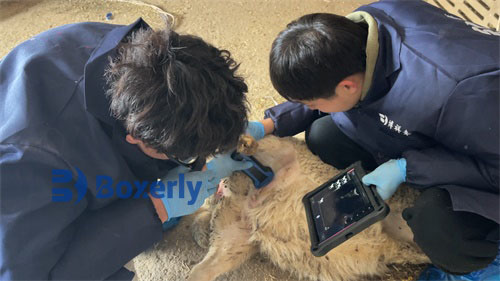As a sheep farmer—or someone curious about livestock tech—you’ve probably heard of ultrasound scanners for ovine reproduction. Knowing which gear works best isn’t trivial: you’re balancing reliability, usability, ค่า, and what colleagues abroad have to say. So let’s wander together through what’s on offer, what other farmers say, and why certain machines stand out.

Why scan ewes with ultrasound?
Most sheep farmers in places like the UK, ออสเตรเลีย, New Zealand, and the US rely on pregnancy scanning to manage feed, plan lambing schedules, and detect multiples early. Ultrasound gives you a peek inside—detecting pregnancy, estimating litter size, and spotting complications before they become big problems. It’s safer than palpation and gives confidence about management decisions.
Popular scanners on the market today
Across regions, several brands dominate. IMV Imaging’s Ovi‑Scan, the Duo‑Scan:Go and variants, plus machines from Dramiński and Chinese manufacturers are widely used. Many vets and high‑tech producers compare them intensively before buying.
Ovi‑Scan (IMV Imaging)
This compact unit pairs a lightweight probe (Duo‑Scan) with a console. It’s built for dusty, splashy farm environments—IP‑rated, ตะปุ่มตะป่ํา, with a high‑quality screen and a wide 170° field of view. It penetrates to about 28 cm depth and allows counting of lambs reliably. Many users say it’s intuitive even for those new to scanning.
Duo‑Scan:Go Plus
A wireless, ergonomic probe-only device that connects to your tablet or phone. It’s flexible for field use and popular where portability matters most.
Dramiński iScan series
Veterinarians and producers appreciate its waterproof design and multiple probes for sheep, แพะ, และปศุสัตว์อื่น ๆ. Colour‑flow Doppler and interchangeable probes add versatility, although prices are higher.
Chinese entry-level scanners
Manufacturers like Boxianglai, Dawei, Ruisheng offer cost-effective ultrasound scanners for sheep and goats. They often cost between USD 300–1,200, and include convex or rectal probes. Reviews say they work well for basic pregnancy detection, though image quality isn’t as clear as premium brands.
ScanX and MSU‑3 (used/resellers)
In regions like the UK, some breeders scan their own flocks using devices like ScanX or the older MSU‑3 sector scanners. They’re still widely used, especially second‑hand. One user noted that placentomes in sheep can obstruct views, making clarity key—ScanX often provides better fetal visualization than lower‑end sector units.
What overseas users say: voices from the field
On forums and farmer groups from the UK to Australia, feedback helps steer decisions:
-
In New Zealand, a sheep vet observed that Ovi‑Scan reliably spots twins early and provides consistent fertility data, even when used by less experienced staff.
-
Australian sheep producers say wireless Duo‑Scan systems give more freedom on steep terrain—no cables dragging through mud.
-
From the UK, one user shared: “Placentomes make scanning sheep tricky—only machines with sharper resolution let me distinguish lambs clearly.” That echoes experience with ScanX and higher‑end units.
-
Vets using Dramiński gear often praise durable construction and probe choices. A mobile practice in Europe reported its iScan2 performed well during bad weather because it’s fully waterproof and rugged.
Key features to compare
Here’s a quick table breaking down typical specs across equipment choices:
| Model / Brand | Probe Type | Depth (~cm) | Field View | Price Range | Best For |
|---|---|---|---|---|---|
| Ovi‑Scan (IMV) | 3.5 MHz axial convex | ~28 cm | 170° console view | Premium (request quote) | Accurate lamb counts on farm |
| Duo‑Scan:Go / Plus | Wireless convex probe | ~25–28 cm | Tablet/smartphone screen | Mid‑high | Portable scanning in rough terrain |
| Dramiński iScan2 / 3 | Interchangeable (rectal, back‑fat) | varies 20–30 cm | Standard console | High | Multi‑function vet use |
| Boxianglai / บีเอ็กซ์แอล-V50 | Convex or rectal probe | ~20–25 cm | Small LCD | Low–mid (USD 300–1 200) | Basic pregnancy detection |
| ScanX / MSU‑3 (used) | Mechanical sector probe | ~20 cm | Narrow sector field | Used‑market pricing | Experienced users needing basic scan |
Practical considerations before buying
Ease of use: For farmers not trained in scanning, systems like Ovi‑Scan or Duo‑Scan offer guided views, clear imaging, and fewer settings to fiddle with.
Image clarity: Recognizing multiples, fetal viability, or abnormalities relies on sharp resolution, especially when placentomes obscure the view.
ความทนทาน: Features like splash/dust proofing and robust casing matter if you scan in barns or on rainy hills.
Battery life & การพกพา: Wireless probes with integrated batteries—like Duo‑Scan:Go—allow scanning remote fields, whereas console models may need mains power or heavy battery packs.
Service and training: IMV and Dramiński often include training and have support networks in many countries. Lower‑cost brands may lack warranty support in your region.
Cost vs volume: A small flock might justify a basic Chinese scanner. Larger operations or herd‑testing services may invest in premium gear since accuracy and throughput boost long-term ROI.

Real‑world example: using ultrasound in flock management
In a typical flock of 500 ewes:
-
Scan at around day 60 of gestation to confirm pregnancy and count lambs.
-
Use scan data to decide on feeding tiers—for singles, twins, triplets.
-
Schedule lambing groups by scanning results, improving labour planning.
-
Detect any non‑pregnant ewes early and manage breed cycles proactively.
-
Monitor flock fertility across seasons and fine‑tune ram ratios as needed.
Farmers in regions with high feed costs say that knowing litter size allows targeted feeding strategies—lean ewes get different ration than those carrying multiples. Ultrasound becomes a decision tool, not just a yes/no answer.
Pros and cons at a glance
| Benefit | Challenge |
|---|---|
| Non‑invasive, safe for ewe and operator | Accuracy depends on operator skill |
| Early detection of pregnancy and litter size | Some machines struggle with placentomes |
| Efficient resource allocation and feed planning | Initial cost can be high |
| Portable units allow scanning in remote paddocks | Training and maintenance needed |
| Durable models endure field conditions | Cheaper units often lack service options |
Listening to international users
One skilled scanner from Australia commented: “Switching to Duo‑Scan:Go gave me more flexibility during mustering—they’re lighter, tether‑free. I scan right off the quad bike.”
A UK vet added: “I trust Ovi‑Scan on large commercial flocks—it rarely misses twins, which is crucial when the income per ewe counts.”
Meanwhile, entry‑level Chinese units get praise for giving small producers access to scanning tech at a low barrier to entry. But image quality and support differ greatly.
Tips to test machines before buying
-
Ask for a demonstration on live ewes, ideally in similar lighting, terrain, and weather conditions you work in.
-
Check how easy it is to clean between scans. A waterproof unit saves time in muddy yards.
-
Try scanning ewes with twins and singleton fetuses to assess clarity.
-
Test battery life and screen readability in bright daylight.
-
Assess how intuitive the interface is. If staff or family help with scanning, choose one with minimal complexity.
Final takeaways
Sheep scanning equipment has evolved far beyond basic pregnancy checks. With modern ultrasound systems, you’re buying into accurate lamb counts, early identification of issues, better feed and lambing logistics—and more confident flock management.
If you want crisp images, strong support, and comfort scanning all day, machines like Boxianglai‑Scan, Duo‑Scan:Go, และ Dramiński iScan models offer performance vets and large producers depend on. For smaller flocks or budget‑limited farms, lower‑cost scanners from manufacturers like Boxianglai can do the job—if you’re willing to trade some clarity and support.
Ultimately, talking to overseas users—bloggers, vets, sheep‑farming groups—can guide you toward a brand that fits your terrain, flock size, and workflow rhythm. People in New Zealand love their IMV gear, Australians rave about wireless freedom, and rural UK producers still lean on ScanX or refurbished units for basic scanning.